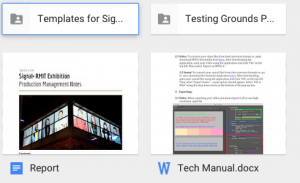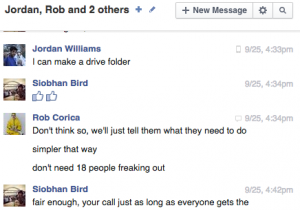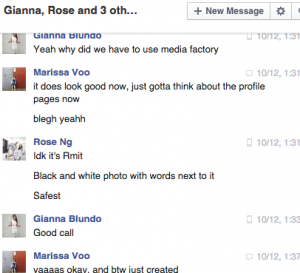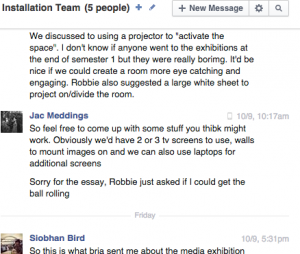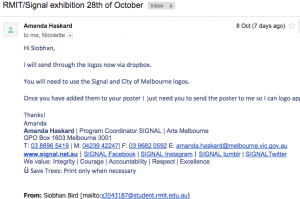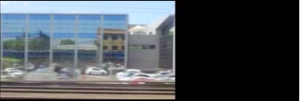In the collaboration with Signal I shared the role of Production Manager with Nicolette. Together we were responsible for overseeing the coordination of the whole project. We had to organize groups and delegate roles. We ensured every team was told their responsibilities and understood the breakdown of tasks. We created documents that were accessible by everyone with information about the overall aims of the project as well as a calendar with all of the important dates.
Initially we worked with the tech team to organize the technical requirements including templates, these were used as a base format for everyone to insert their films and footage so the size and shape of their work would suit the elongated, horizontal format in which Signal projects the work. Formats and saving and exporting requirements were also communicated to the class to ensure everyone’s work was consistent and could be easily edited together and compatible with the technology at Signal. The tech team was responsible for collecting everyone’s work on an external hard drive which we then compiled and curated an order for, for the Signal exhibition footage.
We then worked with the PR team to ensure a Facebook event was created, as well as various flyers and posters to promote the event appropriately, these had to be approved by Signal. We had promotional posters which were pinned up and handed out at various locations. Booklets with portraits of each student, thumbnails of their work and a blurb summing up the art, there were primarily for people who attended the opening in order to inform them about what they were viewing. A website was also set up with this information as well as other information from the Specific to Site course, this is to be used to promote the Signal exhibition as well as inform interested participants and possible future students about the course. I assisted with some of the editing of the website by compiling thumbnails of students work and inserting them into a webpage. The PR team also organized for the event details to be broadcast over the Uni radio.
We worked with the documentation team to organize the documenting of the exhibition process, this documentation was then to be edited by the editing team in order to present at the media night. The documentation team took photos of each student to be used for the portraits on the website and booklet. This team also collected various pieces of students work in order to compile a trailer for Signal, this was posted on Facebook for public viewing. This work was also used on exhibition night to present to other students as a demonstration of our work through out the semester. This team also produced a PowerPoint as visual stimuli to run in the background through out the speech summing up the course.
Lastly we worked with the instillation team who was responsible for collecting material for the media night and organizing a means of presenting it. We fed them details of exhibition times, room location and layout and the various facilities available to present our work. Their role was to collect extra essential material and curate, which works would be on which screens e.c.t
Communication was a vital part of the production manager role. I set up various Facebook messages for each group in order for them to keep in contact with each other and update me about their progress. As well as keeping in contact with the other students Nicolette and I also had to conduct various conversations with the staff at Signal to coordinate flyers, posters and other promotional material. This material had to be approved by Signal and various requirements had to be met including the incorporation of the Signal logo at a certain size and the use of the city of Melbourne logo, which also had to meet various size and location requirements. Contact was also made with Brian involving information regarding the media exhibition night such as times, locations, facilities and layout restrictions. These had to be communicated to the instillation team in order for them to organize the exhibition night.
Extra promotion Nicolette and I tried to organize included sponsorship by various companies who may have been willing to provide discounted products in order to draw crowds to the Signal exhibition. Unfortunately this proved to be too costly. We also tried to organize food and drinks to be available on opening night on order to create the essence of an official event. Unfortunately alcohol was prohibited as Signal is part of City Of Melbourne. Food was also going to be difficult to co ordinate because it required staff presence and monitoring which again proved too costly. Instead we settled for a casual opening which consisted of a brief speech and dinner and drinks afterwards at a near by bar.
Other challenges throughout the process included communication challenges. Some groups were constantly available, willing to take on extra work to ensure a smooth exhibition and create the best possible opening event. Others were hard to get in contact with, they didn’t respond to messages, Facebook posts and emails and were not willing to pick up the slack. This left roles unfairly divided with some taking on allot and others taking on minimal work. Many team members took initiative to come up with their own ideas and input their own creative influences, others struggled to show initiative and take control and responsibility of their roles. There were also communication issues when communicating with teams and Signal, when various people are involved in the same job we were often receiving different and contradictory information from different sources which made the process confusing.
The importance of leadership. The production team was required to delegate tasks and divide up roles. We had to show responsibility and initiative and ensure everyone was on top of their tasks. We had to be available for communication and assistance when groups were unclear with what they were doing or how it slotted in with other teams work. Especially we had to unite the different groups and bring everything together
As a part of Specific to site I have learned the importance of connecting your environment with your work. Art can be particularly effective when it is specifically designed for a unique art space and alternative way or presentation such as Signal or Testing Grounds.Quality is essential when presenting art and a simplistic piece that is executed well can be far more effective then a lo fi piece with lots going on that has all been thrown together without thought or consideration. It is important to connect your work with other elements of your life. The process of reflection can give you new insights to your work. Reading articles and observing your surroundings and then connecting these to your work can stimulate new thought processes and cause your work to evolve and adapt into art that is more likely to be engaging and intriguing to audiences.

